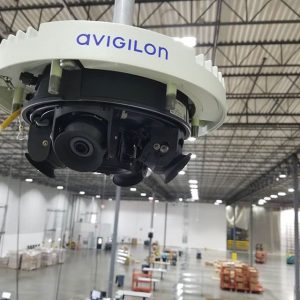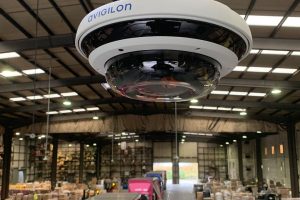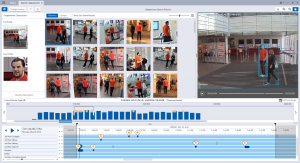Planning your surveillance system is key to its success.
Contact Us, and we’ll support you from design to implementation and maintenance.
Keeping personnel, facilities, job sites, and equipment safe is a top priority for business owners and managers across Alberta, and video surveillance systems are the tools they are turning to, more and more often. CCTV cameras act as a deterrent to reckless and criminal behavior simply by being present. And, in modern systems, cameras equipped with video analytics can make monitoring video footage easier and investigations more efficient.
managers across Alberta, and video surveillance systems are the tools they are turning to, more and more often. CCTV cameras act as a deterrent to reckless and criminal behavior simply by being present. And, in modern systems, cameras equipped with video analytics can make monitoring video footage easier and investigations more efficient.
But don’t let the benefits fool you. Getting the most out of your video surveillance system will require careful, deliberate planning. You’ll need to consider the options available and (more importantly) how well they stack up against your needs. If you rush or skip the planning process, you could end up with gaps in your security system.
If you’d like to start a conversation and get that process going, Contact Us. Until then, these are the mistakes you and your team should avoid when it comes to buying CCTV cameras.
Going for the Cheapest Option BECAUSE It’s Cheapest
Your budget is a limited resource and you have to spend it effectively. But, buying the cheapest gear available may not be the way to do that. That approach may leave you with some budgetary wiggle room at the end of the day, but it could also leave you with substandard equipment and coverage.
What does that look like? The list of problems and frustrations that could pop up is a long one. The resolution may be low, leaving you with blurry images that are less than ideal when trying to identify people, license plates or safety hazards. A cheap solution means weak, or even non-existent, video analytics features. That means tedious investigation cycles as your security staff spends hours watching CCTV footage, searching for useful information. Robust video analytics, on the other hand, could reduce that to minutes, and even alert you if an incident seemed likely to occur.
Ignoring the Need for Waterproofing and Dust-proofing
CCTV cameras are used outdoors on a regular basis. You can find them in parking lots and on the outer walls of buildings in Edmonton, Calgary, Fort McMurray and all over the rest of Alberta. But installing cameras outside means you’ll have to deal with wind, dust, water, and snow.
When you buy cameras or any electronics that you’ll use outdoors, check for its ingress protection. The rating will tell you how well protected the device is against dirt, dust, and water from entering the camera’s housing and damaging the components. The higher the rating, the better the protection.
Buy cameras that are right for the conditions and they will last. Ignore waterproofing and dust proofing, and the equipment will constantly be in need of repair or replacement.
Ignoring Lighting Conditions
If you need to secure an outdoor area, like a parking lot, or the interior of a building after hours, then you need CCTV cameras that can capture useful footage in low light conditions, or even complete darkness.
Cameras with infrared LED lighting can do this because they create a shape based on the heat that radiates from a person or vehicle. This means they can track movement in the dark, which can be critical for organizations trying to prevent break-ins, theft, vandalism, and trespassing.
If this sounds like you, then be sure the cameras you’re considering have low light capabilities.
Not Considering the Floor Plan
The area you plan on monitoring – be it indoor or outdoor – is really the most important factor. Knowing the size and dimensions of that area will largely determine the type (and number) of cameras you need.

On the other hand, if you need coverage in a warehouse or a manufacturing facility, that could easily require multiple cameras. You’ll have to account for longer distances and the powerful zoom lenses you may require. You’ll have to account for obstructions to the camera’s field of view, like shelving and machinery.
Getting your hands on an actual floor plan of the area in question might be the best place to start. You’ll be able to map out the range needed, lines of sight, and any potential obstructions. Knowing all that will give you a good idea of how many cameras you need, and what their capabilities have to be.
Not Investing in Video Analytics
We mentioned that cheap cameras meant cheap or non-existent video analytics features. Buying the right cameras is one way to avoid that, and getting the right software is another.
Open platforms like the Avigilon Control Center will allow you to make use of a camera’s analytical abilities quickly and easily. The intuitive design of the platform means your security team will be able to make use of features like Facial Recognition, License Plate Recognition, Unusual Motion Detection, and a suite of others with relatively little training.
Being able to make use of these, and other analytics-based search tools will allow your team to do their jobs more efficiently. For managers, that means more effective use of security personnel. Once you can start streamlining the process of reviewing CCTV footage, fewer people will be required to do it. Those team members can then be redeployed to areas that require a stronger security presence or rescheduled to work during different times, as needs warrant.
Choosing not to invest in analytics-capable cameras and software, or in the time required to learn how to use them means you won’t get the benefits described above.
Not Planning for the Future
As your business grows and changes, so will your security needs. If your current system can’t scale up and adapt, the options aren’t great. You might be left with gaps in your security, systems built in an ad hoc manner, or worst of all, you could be forced to rebuild your entire system.
There are ways you can prepare your current security system so that it makes this growth easier to manage. Choosing a video management system like the Avigilon Control Centre, which allows more cameras to be incorporated, is one. Using modern cabling types to support your cameras (ethernet over coaxial) is another.
When you start designing your video surveillance system, be sure to talk to your provider about how best to future-proof it. That way, it’ll be able to easily grow when you need it to.
Getting Started
Generally speaking, the mistakes made in building a video surveillance system start when decisions are rushed, and then they snowball from there. We mentioned that buying the cheapest solution just to save money can leave your system with gaps and shortcomings but buying the most expensive option may leave you with a system that is surplus to your requirements. You might end up with features you don’t actually need.
Planning is key. If you’re ready to start that process, don’t hesitate to Contact Us. Our Account Managers and Service Technicians are here to help.
Tridon is a full solution Telecom Systems Integrator with CSA certification and licensed by APEGA. Our Engineering, Service, and Tower Divisions collaborate with customers to build engineered solutions including communications systems design, tower inspections, and co-location, wireless broadband, fiber optic cabling, site security, and two-way radio communication.




